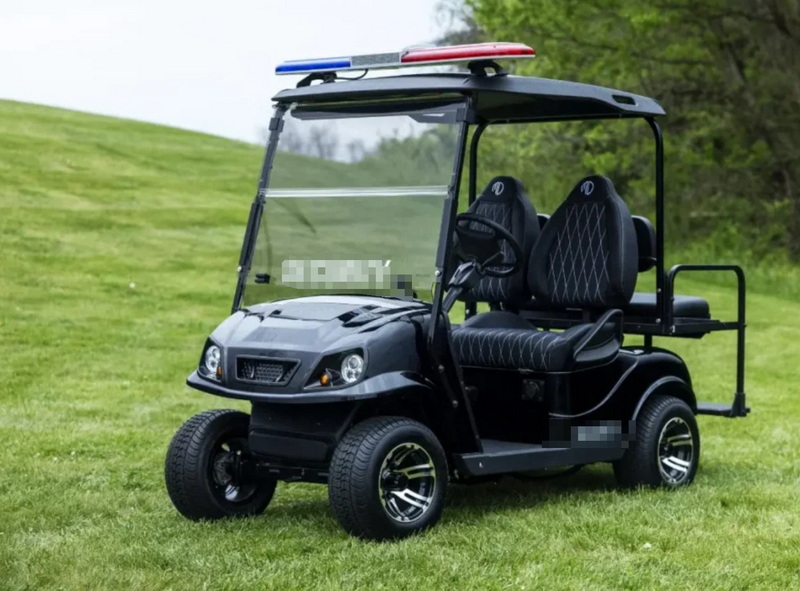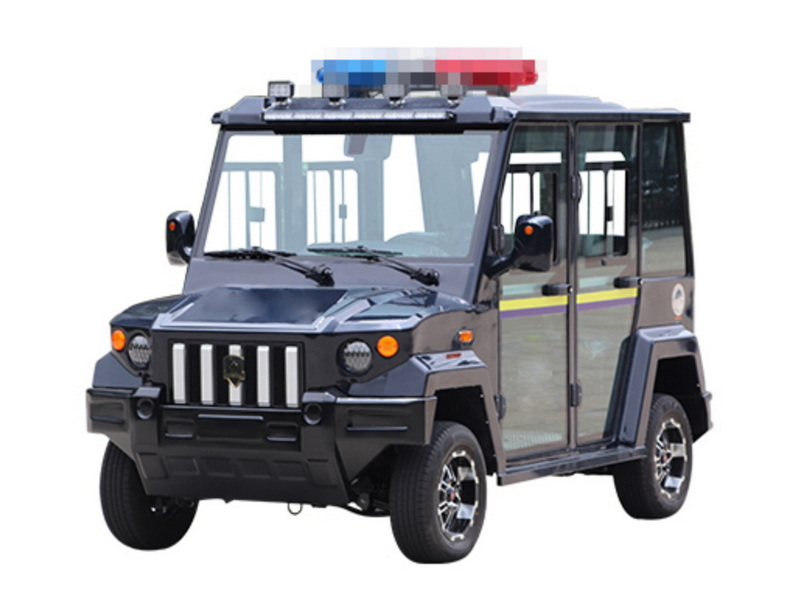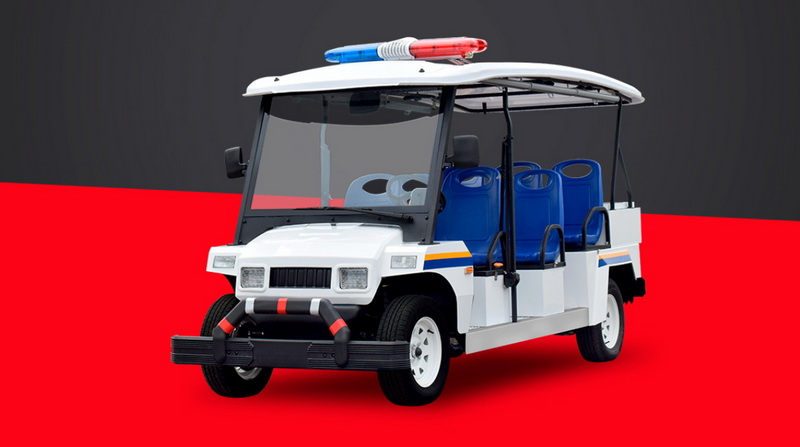Content Menu
● Understanding Electric Patrol Carts
● Terrain Handling Capabilities of Electric Patrol Carts
>> Suitable Terrains
>> Limitations on Rough Terrains
>> Comparison with ATVs (All-Terrain Vehicles)
● Customization and Upgrades for Terrain Adaptation
● Safety and Operational Features
● Practical Applications by Terrain Type
>> Urban and Campus Patrols
>> Hospitality and Resort Use
>> Industrial and Agricultural Settings
>> Limitations in Extreme Environments
● Environmental and Economic Benefits
● Maintenance and Longevity Considerations
● Future Trends in Electric Patrol Carts
● Conclusion
● FAQ
>> 1. Can electric patrol carts handle steep or rocky terrains?
>> 2. What modifications can improve an electric patrol cart's off-road capabilities?
>> 3. How do electric patrol carts compare environmentally to gas-powered ATVs?
>> 4. Are electric patrol carts safe for use in crowded pedestrian areas?
>> 5. What is the typical range and speed of an electric patrol cart?
Electric patrol carts have become increasingly popular in various sectors such as security, hospitality, and recreational areas. Their quiet operation, environmental friendliness, and ease of use make them an appealing alternative to traditional gas-powered vehicles. However, a critical question remains: Are electric patrol carts suitable for all types of terrain? This comprehensive article explores the capabilities, limitations, and practical applications of electric patrol carts across different terrains, comparing them with other off-road vehicles like ATVs, and providing insights into their customization and safety features.

Understanding Electric Patrol Carts
Electric patrol carts are low-speed electric vehicles designed primarily for patrolling and transportation in controlled environments such as campuses, resorts, parks, and urban areas. They typically feature:
- Quiet, emission-free electric motors
- Seating for 2 to 14 passengers depending on the model
- Speeds ranging from 12 to 28 km/h (7.5 to 17 mph)
- Driving ranges of 80 to 100 km on a single charge
- Customizable options including police lights, megaphones, and surveillance equipment
These carts are engineered for efficiency, maneuverability, and safety in relatively smooth or moderately uneven terrains.
Electric patrol carts are powered by rechargeable batteries, most commonly lithium-ion or lead-acid types. Lithium-ion batteries offer longer life, lighter weight, and faster charging times, making them increasingly favored in newer models. The electric motor delivers instant torque, which is beneficial for stop-and-go patrols and smooth acceleration, especially in urban or campus environments.
Terrain Handling Capabilities of Electric Patrol Carts
Suitable Terrains
Electric patrol carts excel in:
- Urban and paved surfaces: Smooth roads, sidewalks, and pedestrian zones where noise and emissions need to be minimized. Their compact size allows easy navigation through crowded areas.
- Light off-road conditions: Well-maintained trails, grassy fields, and flat dirt paths. With modifications such as off-road tires and suspension upgrades, they can handle these terrains comfortably.
- Indoor and semi-indoor environments: Airports, hospitals, shopping malls, and large enterprises where maneuverability and low noise are essential.
These environments typically feature relatively even surfaces with minimal obstacles, allowing electric patrol carts to operate efficiently and safely.
Limitations on Rough Terrains
While electric patrol carts can be adapted for some off-road use, they are not designed for extreme or rugged terrains. Challenges include:
- Steep hills and rocky landscapes: Limited ground clearance and lower torque compared to ATVs restrict their ability to climb or traverse uneven rocky surfaces. The electric motor's power output and battery capacity are generally optimized for flat or gently sloping terrain.
- Mud, sand dunes, and marshy areas: Their lighter weight and tire design may cause them to get stuck or lose traction. Unlike heavier off-road vehicles, electric patrol carts lack the weight and specialized tires needed to maintain grip in soft or slippery conditions.
- Heavy-duty hauling on rough terrain: They have limited carrying capacity and suspension robustness compared to specialized off-road vehicles. Overloading or driving on very uneven terrain can strain the battery and mechanical components.
Comparison with ATVs (All-Terrain Vehicles)
| Feature | Electric Patrol Carts | ATVs |
| Terrain Capability | Light off-road, paved, grassy areas | Rugged off-road, rocky, mud, sand dunes |
| Ground Clearance | Lower | High |
| Speed | 12-28 km/h (7.5-17 mph) | Up to 70 mph |
| Noise Level | Very quiet (electric motor) | Louder (gas engines) |
| Safety Features | Basic, with optional upgrades | Advanced (roll cages, seat belts) |
| Maintenance | Low maintenance, fewer moving parts | Higher maintenance due to engine complexity |
| Environmental Impact | Zero emissions | Higher emissions |
| Customization | High (police lights, surveillance, branding) | Moderate |
ATVs are better suited for intense off-roading, steep inclines, and rough terrains, while electric patrol carts are ideal for quieter, lighter-duty patrols in less demanding environments.
Customization and Upgrades for Terrain Adaptation
Electric patrol carts can be enhanced to improve their terrain handling capabilities:
- Off-road tires: Larger, knobby tires improve traction on dirt and grass. These tires provide better grip and reduce the risk of slipping on uneven or loose surfaces.
- Lift kits and suspension upgrades: Increase ground clearance and absorb shocks from uneven surfaces. Upgraded suspension systems can significantly improve ride comfort and vehicle stability on bumpy terrain.
- Winches and skid plates: Help in navigating obstacles and protecting the undercarriage. Winches can assist in self-recovery if the cart becomes stuck, while skid plates shield vital components from damage.
- Advanced battery and motor upgrades: Provide additional power for more demanding terrains. Higher-capacity batteries extend range and power output, while more robust motors improve torque for climbing and acceleration.
Such modifications expand their usability but still fall short of the capabilities of specialized off-road vehicles. It is important to note that extensive modifications may affect warranty coverage and vehicle safety certifications.

Safety and Operational Features
Electric patrol carts are designed with safety and operational efficiency in mind:
- Safety: Lower speeds reduce accident risks; some models offer impact-resistant bodies, high-visibility lighting, and optional seat belts. Many models come equipped with emergency stop buttons and horn systems to alert pedestrians.
- Quiet operation: Ideal for stealth patrols in sensitive environments like hospitals or wildlife areas. The electric motor produces minimal noise, reducing disturbance.
- Advanced technology: Integration of GPS, communication systems, and surveillance cameras enhances security operations. Real-time tracking and two-way communication improve response times and situational awareness.
- Long-range and rapid charging: High-capacity batteries allow extended patrols with quick recharge times, improving operational efficiency. Some models support fast-charging stations that can recharge batteries to 80% in under an hour.
However, they lack some of the rugged safety features of ATVs, such as roll cages, which are important for extreme off-road conditions. Operators must be trained to drive electric patrol carts safely, especially when navigating uneven terrain or crowded areas.
Practical Applications by Terrain Type
| Terrain Type | Suitability of Electric Patrol Carts | Typical Use Cases |
| Urban Pavement | Excellent – smooth surfaces, crowded areas | Campus security, pedestrian zones, airports |
| Light Off-Road | Good – grassy fields, well-maintained trails | Parks, golf courses, resorts |
| Moderate Off-Road | Possible with upgrades – dirt paths, mild inclines | Large estates, agricultural properties |
| Rugged Off-Road | Not recommended – rocky, muddy, steep inclines | Use ATVs or specialized vehicles |
| Indoor/Semi-Indoor | Excellent – quiet, maneuverable | Hospitals, malls, event venues |
Urban and Campus Patrols
Electric patrol carts are particularly well-suited for urban environments and campuses. Their quiet operation helps maintain a peaceful atmosphere, while their compact size allows them to navigate narrow pathways and crowded pedestrian zones. Security personnel can quickly respond to incidents without disturbing the environment.
Hospitality and Resort Use
In resorts and golf courses, electric patrol carts provide an environmentally friendly way to transport staff and guests. Their ability to handle grassy and dirt paths with minor upgrades makes them versatile for these settings. Additionally, their quiet operation preserves the tranquility of leisure areas.
Industrial and Agricultural Settings
In large industrial complexes or agricultural properties, electric patrol carts can be used for routine inspections and transport. While they may require modifications for moderate off-road terrain, their low maintenance and operational costs make them attractive alternatives to gas-powered vehicles.
Limitations in Extreme Environments
For rugged terrains such as mountainous regions, dense forests, or muddy wetlands, electric patrol carts are generally unsuitable. In these cases, specialized off-road vehicles with high ground clearance, powerful engines, and advanced suspension systems are necessary to ensure safety and effectiveness.
Environmental and Economic Benefits
Electric patrol carts offer significant environmental benefits compared to traditional gas-powered vehicles:
- Zero emissions: They produce no tailpipe emissions, reducing air pollution and greenhouse gas output.
- Reduced noise pollution: Their quiet operation is less disruptive to wildlife and humans.
- Lower operating costs: Electricity is generally cheaper than gasoline, and electric motors require less maintenance.
- Sustainability: Many models use recyclable batteries and eco-friendly materials.
From an economic perspective, organizations benefit from lower fuel costs, reduced maintenance downtime, and potential incentives for using green vehicles. These factors make electric patrol carts an attractive investment for sustainable operations.
Maintenance and Longevity Considerations
Electric patrol carts require less maintenance than gas-powered vehicles due to fewer moving parts and no need for oil changes or fuel system upkeep. However, battery health is critical:
- Battery care: Proper charging practices and temperature management extend battery life.
- Tire and suspension checks: Regular inspections ensure safe operation, especially if the cart is used on uneven terrain.
- Electrical system monitoring: Ensures that motors, controllers, and wiring function correctly.
Routine maintenance schedules and operator training contribute to the longevity and reliability of electric patrol carts.
Future Trends in Electric Patrol Carts
Advancements in electric vehicle technology continue to enhance patrol carts:
- Improved battery technology: Solid-state batteries and faster charging will increase range and reduce downtime.
- Autonomous capabilities: Integration of AI and sensors may enable self-driving patrol carts for routine monitoring.
- Enhanced terrain adaptability: Innovations in suspension and tire technology will expand off-road usability.
- Smart connectivity: Real-time data sharing with security networks will improve incident response.
These trends suggest that electric patrol carts will become even more versatile and capable across various terrains in the near future.
Conclusion
Electric patrol carts are highly suitable for a wide range of terrains, particularly urban, paved, and light off-road environments. Their quiet operation, environmental benefits, and customizable features make them ideal for security patrols, hospitality, and recreational uses. However, they are not designed for extreme off-roading or highly rugged terrains where ATVs or other specialized vehicles excel. Modifications can enhance their terrain capabilities but within limits.
Choosing between electric patrol carts and other vehicles depends on the specific terrain, operational needs, and safety requirements. For most light to moderate terrains, electric patrol carts offer a practical, efficient, and eco-friendly solution that balances performance with sustainability.

FAQ
1. Can electric patrol carts handle steep or rocky terrains?
No, electric patrol carts are not designed for steep or rocky terrains due to limited ground clearance and power. They are best suited for light off-road use and paved surfaces. For rugged terrain, ATVs or specialized off-road vehicles are recommended.
2. What modifications can improve an electric patrol cart's off-road capabilities?
Installing off-road tires, lift kits, suspension upgrades, winches, and skid plates can enhance their ability to handle rougher terrains. However, these modifications have limits and cannot fully substitute for a purpose-built off-road vehicle.
3. How do electric patrol carts compare environmentally to gas-powered ATVs?
Electric patrol carts produce zero emissions and operate quietly, making them more environmentally friendly and suitable for noise-sensitive areas. They also have lower operating costs and reduced maintenance requirements.
4. Are electric patrol carts safe for use in crowded pedestrian areas?
Yes, their low speed, maneuverability, and optional safety features like high-visibility lighting make them safe and effective for crowded urban and pedestrian environments. Proper driver training is essential to ensure safety.
5. What is the typical range and speed of an electric patrol cart?
Most electric patrol carts have a top speed between 12 to 28 km/h (7.5 to 17 mph) and can travel 80 to 100 km on a single charge, depending on the model and terrain.










































